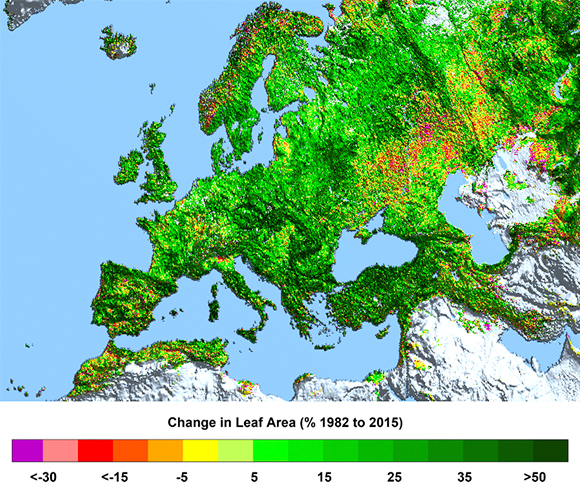The world has become greener over the past 33 years
Since 1982, Earth has become greener in an area covering 36 million km2, close to two times the size of the United States. Above all, this seems to be the result of a fertilizing effect of atmospheric carbon dioxide (CO2) on plants. The study was carried out with satellite images which can capture this increase in terrestrial leaf area.

Earth is now greener than it was three decades ago. This is the main conclusion of an international study including CSIC and CREAF researcher Josep Peñuelas, published April 25th in the journal Nature Climate Change. The study detected a significant increase in green biomass – essentially, leaves – over 40% of the planet from 1982 to 2015, while a significant decrease in vegetation was seen in only 4% of the surface.
“With this study, we have been able to attribute greening of the planet to increases in atmospheric CO2 levels resulting from fossil fuel consumption”, says Peñuelas. With more carbon dioxide available, plants have been able to create more leaves through photosynthesis, and as a result the rate of increase in concentration of the greenhouse gas has slowed.
This large amount of greening “could be capable of changing water and carbon cycles on the global scale”, adds Josep Peñuelas. Previous studies had already confirmed that plants have been able to store increasing amounts of carbon since the year 1980, agreeing with the notion of greening at the planetary scale which the study bolsters.

CO2 emissions continue to be a problem
However, this does not mean that the increase in atmospheric CO2 is good for climate. Despite the greater number of leaves, “climate change, the increase of global temperature, the increase in sea level, deicing, and the fact that tropical storms are getting strong are all still true”, says Peñuelas. He adds, “the fertilizing effect of carbon dioxide lessens as plants acclimate to the change or begin to have deficits of other resources necessary for their growth such as water or nutrients, and above all phosphorous".
This fertilization with CO2 is the main reason (70% of the time) why Earth is greening. However, the study also identifies climate change (8%), atmospheric nitrogen (9%), and land use changes (4%) as other important factors which will require continued monitoring to understand how vegetation continues changing at the planetary scale.
ARTICLE
Zhu, Z., Peñuelas, J., et al. Greening of the Earth and its divers. (2016) Nature Climate Change. DOI: 10.1038/NCLIMATE3004







